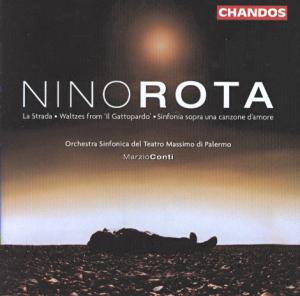Suite from the Ballet La Strada (1966)
Nino Rota
with Salvatore Grecco (violin) and Salvatore Piazza (trumpet)
- Nozze in campagna – È arrivato Zampanò
- I tre suonatori e il ‘Matto’ sul filo
- Il Circo (II numero di Zampanò) – I giocolieri – Il violino del ‘Matto’
- La rabbia di Zampanò
- Zampanò uccide il ‘Matto’ – Gelsomina impazzisce di dolore
- L’ultima spettacolo sulla neve – ‘Addio Gelsomina’ - Intermezzo
- Solitudine e pianto di Zampanò
Sinfonia sopra una canzone d’amore (Symphony on a love song) (1947)
Two waltzes from Il Gattopardo (The Leopard) (1962)
Orchestra Sinfonica del Teatro Massimo di Palermo conducted by Marzio Conti.
(recorded at the Teatro Massimo, Palermo, Italy; 19-21 July 2002)
Available on CHANDOS CHAN 10090
Running time: 64.04
Crotchet

Nino Rota never made any distinction between his concert music and his music for films – each was of equal importance and, to his mind, deserved equal dedication. This valuable album shows an inter-relationship between the two genres. Rota’s music for Fellini’s film La Strada (1954) became the source for the music for the 1966 ballet of the same name and music from Rota’s Sinfonia sopra una canzone d’amore (Symphony on a love song) were used in two films: The Legend of the Glass Mountain (1949) and Il Gattopardo (The Leopard) (1962).
Conti and his Palermo players give a vital and powerful performance of the La Strada ballet suite arranged in seven movements that are entitled as per the header above (it would have been helpful if Chandos had given us an English translation). The story of La Strada concerns Gelsomina (Giuletta Masina in the film) a simple-minded waif who is sold into virtual slavery as assistant to Zampanò (Anthony Quinn in the film), a Brutish travelling strong man. Abused and misused, she unwittingly exacts a terrible revenge as her quiet reproachfulness comes to haunt the strong man to the end of his days. The music spans many genres: colourfully brash and breezy circus music with the brass suggesting not only the buffoonery of the clowns but also the ferociousness of the beasts; grotesque material and wild music for Zampanò’s brutality that recalls the Stravinsky of The Rite of Spring; and vibrant jazz blues and a jokey Rumba. But most memorable is Gelsomina’s celebrated mournful trumpet theme which is also given to the violin in a most tender rendition. Another highlight is the lovely shimmering sylvan nocturne that is the Intermezzo.
Rota’s Sinfonia sopra una canzone d’amore was written in piano score only in 1947 but not performed in its definitive form until 17 June 1972. He used some of the material heard in the opening movement and at the close of the Finale for the British film The Glass Mountain. Directed by Henry Cass, this was a typical story of its period. about an RAF officer and aspiring composer who is shot down in the Italian Dolomites and nursed by a local girl with whom he falls in love –’trouble is, he has a wife back home so the inevitable emotional tussle ensues. The music from the film featured the great Italian baritone Tito Gobbi and its main theme, the ‘Legend of the Glass Mountain’ became exceedingly popular at the time. It is this music, albeit a little more tentative without the exaggerated romantic bravura of version for the film that is heard in the Sinfonia. But it is with the third and fourth movement that some of Nino Rota’s most glorious music is heard – music that as soon as Visconti, the renowned Italian director, heard it insisted that it be included in Il Gattopardo a story of a proud 19th century Sicilian aristocrat (Burt Lancaster) facing the upheavals of Garibaldi’s raid and its aftermath during the struggle to unite Italy. The third movement, marked Andante sostenuto has the film’s gorgeous noble, romantic theme while the Finale. Allegro impetuoso has that turbulent music that is a whirlwind of passion. It is interesting to note how this passionate music segues into The ‘Glass Mountain’ theme in the closing pages of the Finale.
The programme ends with two waltzes from Il Gattopardo: Valzer Verdi (an unpublished, at the time, waltz by Verdi) and Rota’s lovely lilting romantic Valzer del commiato both featured in the sumptuous climactic ballroom scene.
A wonderful album of Nino Rota’s music straddling the worlds of the concert hall, the ballet stage and the silver screen. It makes a fine companion to Silva Screen's simultaneously released 2CD anthology: The Essential Nino Rota Film Music Collection, also reviewed this month on FMOTW.
Ian Lace
41/2
Return to Index